RARE! WWII RESTRICTED B-29 Superfortress Pacific Air Force Navigators Raid Map
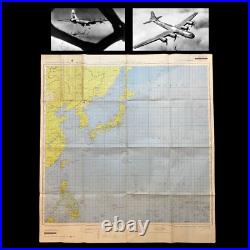
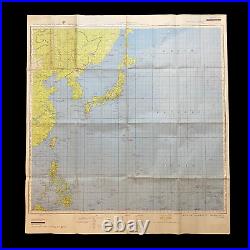
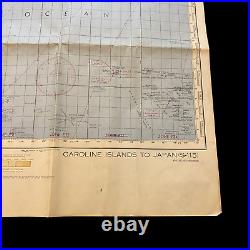
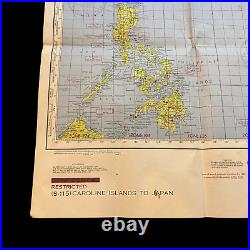
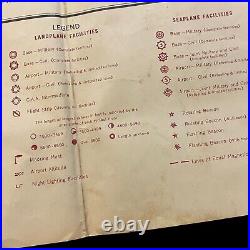
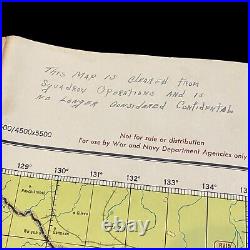
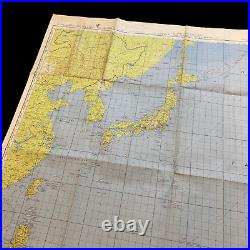
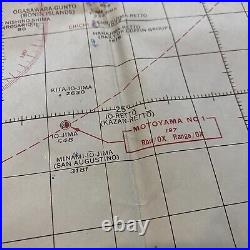
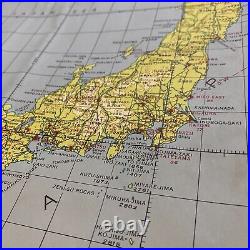
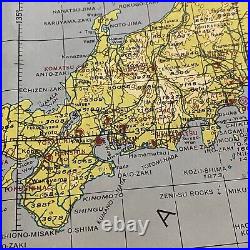
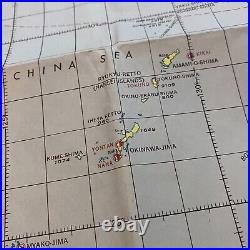

This incredible and museum-grade WWII B-29 Superfortress Pacific Theater map was used by U. B-29 navigators while operating in the Pacific Theater of Operations. Crossed off "CONFIDENTIAL" and marked "RESTRICTED" this operations map was changed to "RESTRICTED" while being used in that combat theater. This navigational map is updated and dated as of APRIL 1945, also infamous of the Battle of Okinawa, codenamed Operation Iceberg. The initial invasion of Okinawa on April 1st 1945 was the largest amphibious assault in the Pacific Theater of World War II. The 82-day battle lasted from 1 April until 22 June 1945. After a long campaign of island hopping, the Allies were planning to use Kadena Air Base on the large island of Okinawa as a base for Operation Downfall, the planned invasion of the Japanese home islands, 340 mi (550 km) away. These B-29 navigator maps were printed extremely large. They were meant to be folded in multiple ways as the bombers moved from island to island using the placements on the map the compass heading to mark and denote the flight path to target or runway. With multiple places on the map for the bombing navigator to place the aerial navigational compass, this map was intended for a wide range of use for bombers and U. Planes across all of the Pacific Islands.
This map played an extremely vital part of the war and was heavily used by a U. Bomber navigators in the Pacific Theater. This map shows some of the most infamous islands in the Pacific from newly captured islands of Iwo Jima, to the Philippines, Peleliu, the Marianas Islands, Okinawa, and the infamous homeland of Japan. Allied forces conducted many air raids on Japan during World War II, causing extensive destruction to the country's cities and killing between 241,000 and 900,000 people.
During the first years of the Pacific War these attacks were limited to the Doolittle Raid in April 1942 and small-scale raids on military positions in the Kuril Islands from mid-1943. Strategic bombing raids began in June 1944 and continued until the end of the war in August 1945.
Allied naval and land-based tactical air units also attacked Japan during 1945. The United States military air campaign waged against Japan began in earnest in mid-1944 and intensified during the war's last months. While plans for attacks on Japan had been prepared prior to the Pacific War, these could not begin until the long-range B-29 Superfortress bomber was ready for combat.
From June 1944 until January 1945, B-29s stationed in India staged through bases in China to make a series of nine raids on targets in western Japan, but this effort proved ineffective. The strategic bombing campaign was greatly expanded from November 1944 when bases in the Mariana Islands became available as a result of the Mariana Islands Campaign. These attacks initially attempted to target industrial facilities using high-altitude daylight "precision" bombing, which was also largely ineffective. From February 1945, the bombers switched to low-altitude night firebombing against urban areas as much of the manufacturing process was carried out in small workshops and private homes: this approach resulted in large-scale urban damage. Aircraft flying from Allied aircraft carriers and the Ryukyu Islands also frequently struck targets in Japan during 1945 in preparation for the planned invasion of Japan scheduled for October 1945. During early August 1945, the cities of Hiroshima and Nagasaki were struck and mostly destroyed by atomic bombs. Japan's military and civil defenses were unable to stop the Allied attacks. Fuel shortages, inadequate pilot training, and a lack of coordination between units also constrained the effectiveness of the fighter force. Despite the vulnerability of Japanese cities to firebombing attacks, the firefighting services lacked training and equipment, and few air raid shelters were constructed for civilians. As a result, the B-29s were able to inflict severe damage on urban areas while suffering few losses. The Allied bombing campaign was one of the main factors which influenced the Japanese government's decision to surrender in mid-August 1945. However, there has been a long-running debate over the morality of the attacks on Japanese cities, and the use of atomic weapons is particularly controversial. The most commonly cited estimate of Japanese casualties from the raids is 333,000 killed and 473,000 wounded. There are a number of other estimates of total fatalities, however, which range from 241,000 to 900,000. In addition to the loss of mostly civilian life, the raids contributed to a large decline in industrial production. The Boeing B-29 Superfortress is an American four-engined.And flown primarily by the United States during. Named in allusion to its predecessor, the. The Superfortress was designed for high-altitude. But also excelled in low-altitude night. Atomic bombs on Hiroshima and Nagasaki.
The only aircraft ever to drop. On 5 June 1944, B-29s raided Bangkok, in what is reported as a test before being deployed against the Japanese home islands. Sources do not report from where they launched and vary as to the numbers involved-77, 98, and 114 being claimed. Targets were Bangkok's Memorial Bridge and a major power plant. Bombs fell over two kilometers away, damaged no civilian structures, but destroyed some tram lines, and destroyed both a Japanese military hospital and the Japanese secret police headquarters.On 15 June 1944, 68 B-29s took off from bases around Chengdu, 47 B-29s bombed the Imperial Iron and Steel Works at Yawata, Fukuoka Prefecture, Japan. This was the first attack on Japanese islands since the Doolittle raid in April 1942. The first B-29 combat losses occurred during this raid, with one B-29 destroyed on the ground by Japanese fighters after an emergency landing in China. One lost to anti-aircraft fire over Yawata, and another, the. Stockett, Aircraft Commander B-29-1-BW 42-6261.
Disappeared after takeoff from Chakulia, India, over the Himalayas (12 KIA, 11 crew and one passenger). This raid, which did little damage to the target, with only one bomb striking the target factory complex.Nearly exhausted fuel stocks at the Chengdu B-29 bases, resulting in a slow-down of operations until the fuel stockpiles could be replenished. Starting in July, the raids against Japan from Chinese airfields continued at relatively low intensity. New Mariana Islands Air Bases. In addition to the logistical problems associated with operations from China, the B-29 could only reach a limited part of Japan while flying from Chinese bases.
The solution to this problem was to capture the Mariana Islands, which would bring targets such as Tokyo, about 1,500 mi (2,400 km) north of the Marianas within range of B-29 attacks. The Joint Chiefs of Staff agreed in December 1943 to seize the Marianas. US forces invaded Saipan on 15 June 1944. Despite a Japanese naval counterattack which led to the Battle of the Philippine Sea and heavy fighting on land, Saipan was secured by 9 July. Operations followed against Guam and Tinian, with all three islands secured by August.
Naval construction battalions (Seabees) began at once to construct air bases suitable for the B-29, commencing even before the end of ground fighting. In all, five major airfields were built: two on the flat island of Tinian, one on Saipan, and two on Guam. Each was large enough to eventually accommodate a bomb wing consisting of four bomb groups, giving a total of 180 B-29s per airfield.The bases became the launch sites for the large B-29 raids against Japan in the final year of the war. The first B-29 arrived on Saipan on 12 October 1944, and the first combat mission was launched from there on 28 October 1944, with 14 B-29s attacking the Truk atoll. The 73rd Bomb Wing launched the first mission against Japan from bases in the Marianas, on 24 November 1944, sending 111 B-29s to attack Tokyo.
For this first attack on the Japanese capital since the Doolittle Raid in April 1942, 73rd Bomb Wing wing commander Brigadier General Emmett O'Donnell Jr. Acted as mission command pilot in B-29. The campaign of incendiary raids started with the bombardment of Kobe on 4 February 1945, then peaked early with the most destructive bombing raid in history even when the later. Flown nuclear attacks on Hiroshima and Nagasaki are considered. On the night of 9-10 March 1945 on Tokyo.
From then on, the raids intensified, being launched regularly until the end of the war. The attacks succeeded in devastating most large Japanese cities (with the exception of Kyoto and four that were reserved for nuclear attacks), and gravely damaged Japan's war industries. This item is in the category "Collectibles\Militaria\WW II (1939-45)\Original Period Items\United States\Field Gear, Equipment". The seller is "premierrelics" and is located in this country: US. This item can be shipped worldwide.
- Theme: Militaria
- Original/Reproduction: Original
- Conflict: WW II (1939-45)
